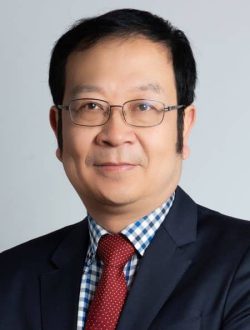Biography
Dr. Chen received a B.Eng. degree in Radio Engineering from Fuzhou University, Fujian, China, a M.A.Sc. degree in Radio Engineering from Southeast University (formerly Nanjing Institute of Technology), Nanjing, China, and a Ph.D. degree in Electrical Engineering from the University of Ottawa, Ottawa, Ontario, Canada, respectively. He is a Professor and the former Head of the Department of Electrical ad Computer Engineering, Dalhousie University, Halifax, Nova Scotia, Canada. He is the Fellow of the Institute of Electrical and Electronics Engineers (IEEE), the Fellow of the Canadian Academy of Engineering (CAE), the Fellow of Engineering Institute of Canada (EIC). He is a registered professional engineer and has served as a consultant for local companies.
Dr. Chen has been active in teaching, research and professional services. He has been teaching various undergraduate and graduate courses in the areas of communication systems, RF/Microwave electronics/systems, antennas, and electromagnetics. He has authored or co-authored over 375 refereed journal/conference papers and 26 industrial reports, published one book, contributed to 2 books, edited 1 research monograph and 1 conference proceeding and, and filed 8 patents in the areas of computational electromagnetics and RF/microwave circuit and system design (some of his publications have been cited extensively in SCI literatures). Dr. Chen was one of the key originators in developing new numerical algorithms and in designing a new class of compact RF circuits and systems for wireless communications. He has been a sole/principal investigator of more than twenty-eight grants from both government and industry, including a NSERC Discovery Accelerator Supplement Grant, NSERC Strategic Project Grants on Ultra-wideband Impulse Radios and novel RF-front ends; an research contract in developing structure composite microwave materials for radar applications (2011-2013); an Atlantic Innovation Fund on generic smart RF transceivers.
Presentations
Unification of Numerical Methods: A General Mathematical Framework for Derivations and New Scheme Developments
Many numerical methods have been developed so far for electromagnetic modeling and simulation. They present different approaches to the approximate solutions of the electromagnetic field governing equations, namely, Maxwell’s equations. They include frequency-domain methods such as the finite-difference frequency-domain (FDFD) method, finite-element (FEM) method and the conventional method of moments (MoM), and the time-domain methods such as the finite-difference time-domain (FDTD) method, transmission-line-matrix (TLM) method, time-domain finite-element (TD-FEM) method, and time-domain integral formulations. On the one hand, these methods have been proven to be effective in solving electromagnetic structure problems with their respective advantages and disadvantages. On the other hand, they appear to have been derived on different mathematical bases, and their solution procedures also appear to be different from each other, presenting challenges and difficulty for students, beginners, and even practitioners in understanding and applying them.
This lecture is intended to show otherwise: all the numerical methods can be generalized or derived with the method of the weighted residuals or method of moments; As the result, an easy way to understand and apply numerical methods is presented, and a new perspective on numerical methods and a new way to develop innovative numerical methods are shown. In particular, unifying concepts among numerical methods are described, and based on the concepts emerging, numerical methods such as meshless, hybrid, and multilevel techniques are demonstrated.
Wireless Power Harvesting and Transfer –Progress and Challenges
Electromagnetics forms the foundation of modern electrical and electronic systems that see the technologies we enjoy and take for granted today. It has been used to transfer information and power in our daily lives. In the wireless domain, however, it had not been considered and employed much for power transfer until 2008, when an MIT research team lead by Prof. Marin Soljacic successfully demonstrated the mid-range wireless power. Since then, many efforts and much progress have been made to improve power transfer efficiency over a distance, reduce system size for consumer products and implantable devices, and include more functionality for communications and sensing applications. The goal is to cut the last wires in electrical and electronic devices and systems, if all possible. In this talk, we will first present the principles of the wireless power harvesting and transfer and then focus on mid-range wireless power transfer and its applications and commercialization. We will present the status, challenges, progresses, and future directions in the areas.
Nonlinear Signal Processing Technologies for Energy Detection Based Impulse Radio UWB Transceivers
Most signal processing technologies employed in impulse radio UWB transceivers are straightforward derivatives of those employed in conventional wireless transceivers. They appear not to take full advantage of the special features, such as ultra-wide bandwidths and very short pulses, offered by the impulse radio UWB transceivers. To move beyond this limitation, different and nontraditional signal processing technologies that fully utilize the unique characteristics of the impulse radio UWB transceivers need to be considered and should be developed. To this end, in this presentation, we present our recent work on the development and use of nonlinear signal processing technologies in energy detection based impulse radio UWB transceivers. We will show that nonlinear signal processing techniques can achieve significant performance improvements over existing signal processing technologies; thus, they present a potentially new horizon in UWB technologies and applications. We will show that nonlinear signal processing technologies, when developed appropriately, can not only mitigate the destructive effects of narrowband interferences but also improve bit error rate performance of energy detection based impulse radio UWB transceivers when no narrowband interference presents. We will also describe our approaches to the challenging nonlinear analysis and our views on the future challenges and possible solutions.
